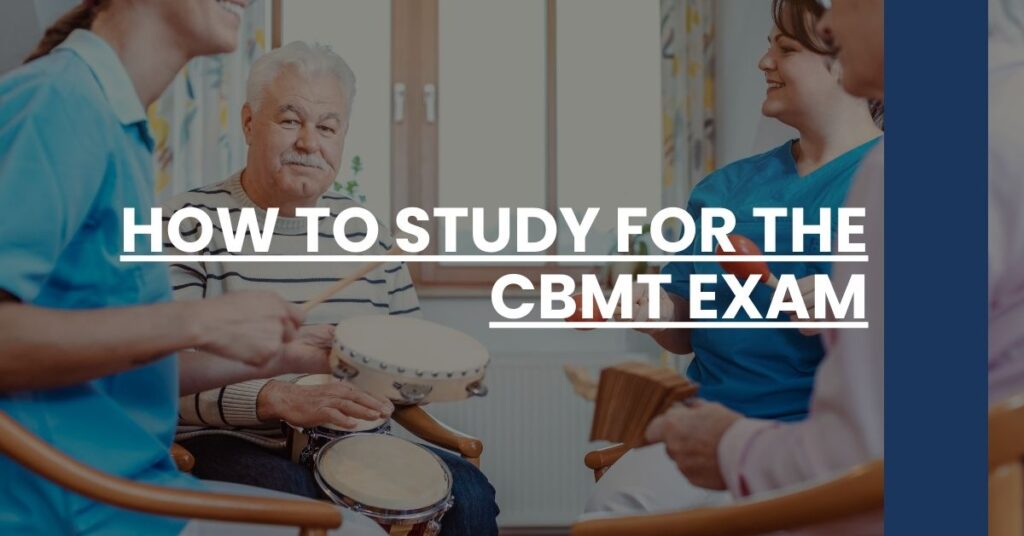How to study for the CBMT exam just got easier with our targeted tips and strategies.
- Tailored Study Schedule: Craft a plan that fits your unique learning style for effective CBMT exam preparation.
- Official CBMT Resources: Utilize authorized materials to align closely with the exam’s format and content.
- Active Learning: Apply interactive techniques to reinforce your knowledge and boost retention for the CBMT exam.
Master how to study for the CBMT exam with confidence and clarity.
- Understanding the CBMT Exam
- Creating a Study Plan
- Utilizing Official CBMT Resources
- Supplementing with Additional Study Materials
- Active Learning Techniques
- Test-Taking Strategies
- Practice Tests and Self-Assessment
- Staying Healthy and Managing Anxiety
- Review Before the Test
- Conclusion: The Final Countdown to Passing the CBMT Exam
Understanding the CBMT Exam
When embarking on the journey to become a board-certified music therapist, you need to conquer a pivotal milestone: the Certification Board for Music Therapists (CBMT) Exam. It’s a test designed to measure the essential knowledge and skills you should have mastered through your academic and clinical training.
Why is the CBMT exam so crucial for aspiring music therapists? For one, holding the MT-BC credential ensures that you adhere to the highest standards of practice and are well-equipped to provide quality care. It covers critical areas, probing your understanding across CBMT Board Certification Domains, shaping a well-rounded and adept practitioner.
What’s on the CBMT Exam?
To figure out how to study for the CBMT exam, familiarize yourself with its contents. Areas of assessment include:
- Assessment and Documentation: Understanding of client assessments, developing treatment plans, and the importance of precise documentation.
- Treatment Implementation and Termination: Knowledge about applying therapy interventions and determining the end of services.
- Ongoing Evaluation and Documentation of Changes: Skill in evaluating the therapy process and its outcomes.
Who Can Take the CBMT Exam?
Before you bury yourself in study guides, ensure you’re eligible. The CBMT exam requires you to have completed a specific range of academic courses and supervised clinical experience. Check the criteria thoroughly to confirm you’re on track.
Creating a Study Plan
Success in the CBMT exam hinges on a solid study plan. Tailoring a schedule to your needs will not only keep you organized but also ensure that you cover all necessary content efficiently. Let’s break down the steps:
- Assess Your Current Schedule: Take stock of your responsibilities and see where your study sessions can fit in without overwhelming you.
- Set Realistic Study Goals: Identify your study objectives, ensuring they are specific, measurable, achievable, relevant, and time-bound (SMART).
- Allocate Time Wisely: Balance your time among the various domains of the CBMT, granting extra time to areas where you feel less confident.
Planning Tools and Techniques
Now, map out your plan using tools like digital calendars or planners. Consider techniques like time-blocking or the Pomodoro Technique to stay focused and maximise your study time.
Utilizing Official CBMT Resources
Direct from the source, official CBMT resources are tailored to the specifics of your upcoming exam. These are indispensable tools that align closely with the test content and format.
- The Candidate Handbook is your go-to for understanding the application process and what to expect on exam day. It’s a wealth of information that should not be overlooked.
- The Self-Assessment Examination (SAE) serves as a practice run. It’s a smart way to familiarize yourself with question formats and a prime opportunity to identify your strengths and weaknesses.
Taking Advantage of the SAE
The Self-Assessment Examination is particularly valuable. Let’s dive into why:
- Pinpoint Areas for Improvement: You’ll see clearly where you need to allocate more of your study time.
- Familiarity with Exam Conditions: Getting comfortable with the examination environment minimizes surprises on the actual test day.
Supplementing with Additional Study Materials
Beyond the core CBMT materials, additional comprehensive resources can bolster your repertoire of knowledge. The real question is, what should you choose? Keep these guiding principles in mind:
- Quality Over Quantity: Select resources with a track record of successful exam preparation. Less is often more if you choose wisely.
- Alignment with CBMT Content: Ensure that supplementary materials cover the domains specified by the CBMT. Misalignments could lead you astray.
Selecting Your Study Aids
Consider incorporating various formats:
- Textbooks: Return to your course textbooks—they are a trove of detailed information.
- Music Therapy Literature: Stay abreast of the latest research and findings in music therapy to enrich your understanding.
Integrating Practical Experience
Application of theory is essential. Seek opportunities for hands-on experience, as these will reinforce your knowledge and boost your confidence.
Active Learning Techniques
Studying doesn’t have to be a passive activity involving endless hours of reading. Engage in active learning to make the content stick. Here’s how:
- Create Flashcards: Test yourself regularly on key terminologies and concepts with this classic technique.
- Construct Mind Maps: For visual learners, mapping out relationships between concepts can be especially powerful.
Group Study Sessions
Consider forming a study group. Here’s what you’ll gain:
- Exchange of Ideas: Sharing knowledge and strategies can help cover more ground.
- Support and Motivation: Keeping each other on track can be very motivating during the study process.
Active engagement in the material not only makes your studies more effective but also keeps them interesting. Remember, when it comes to how to study for the CBMT exam, rooting your strategy in diverse, dynamic, and interactive techniques will serve you well on the path to passing with flying colors.
Test-Taking Strategies
As you close in on the day of your CBMT exam, honing your test-taking strategies can make a significant difference in how you perform. In the same way a musician refines their technique before a performance, you must sharpen your approach to answering questions and managing your time.
Understanding Different Question Types
The CBMT exam will test you with a variety of question types. Familiarizing yourself with these can help reduce surprises and prepare strategic responses:
- Multiple-Choice Questions: These are common and require you to select the correct answer from several options.
- Scenario-Based Questions: Real-world scenarios assess your ability to apply knowledge in practical situations.
- True or False: With a 50% chance of guessing correctly, your ability to discern nuance in the questions is key here.
Managing Time Effectively
Time management is pivotal. Here’s how to ensure you don’t fall behind:
- Monitor the Clock: Keep track of time but don’t let it pressure you. Pacing yourself with a consistent rhythm is crucial.
- Allocate Time Based on Question Complexity: Some questions will naturally require more time than others. Plan accordingly.
Tackling Stress During the Exam
Even the most well-prepared can find exams stressful. To stay calm and focused:
- Mindfulness Techniques: Engage in deep breathing or visualization strategies right before and during the exam.
- Positive Self-talk: Remind yourself of your preparation and use affirmative phrases to boost confidence.
By implementing these test-taking strategies with diligence, you’re positioning yourself to not merely take the CBMT exam but to master it.
Practice Tests and Self-Assessment
Practice makes perfect. This old adage holds especially true when preparing for an exam with the complexity and scope of the CBMT.
The Role of Practice Tests in Preparation
Practice tests are a crucial component in understanding how to study for the CBMT exam, owing to multiple benefits:
- Identify Weaknesses: Mock exams can shine a light on areas needing more attention.
- Real-World Test Conditions: By simulating the exam environment, you become acclimated to the pressure and format.
Constructing a Practice Test Regimen
Here’s how to systematically integrate practice tests into your study regimen:
- Regularly Scheduled Mock Exams: Weekly or bi-weekly, depending on your study timeline, practice exams can structure your preparation.
- Thorough Analysis: Post-test, analyze your answers in detail to understand where you excelled and where improvement is necessary.
Embrace practice tests as a core element of your CBMT exam prep. You’ll find that familiarity with the style and content of the exam through repeated exposure significantly boosts your performance and confidence.
Staying Healthy and Managing Anxiety
Physical wellbeing and mental health can significantly impact your cognitive abilities and therefore, your test performance. Prioritizing these aspects as you study for the CBMT exam could mean the difference between passing and falling short.
Maintaining a Healthy Lifestyle
Adopt habits that can enhance your study efficacy and exam performance:
- Balanced Diet: Nourish your brain with vegetables, fruits, whole grains, and lean proteins.
- Regular Exercise: Physical activity helps reduce stress and can improve concentration.
Addressing Test Anxiety
Test anxiety is common, but its management is essential. Multiple studies, including research published in PMC, indicate that techniques like music interventions can alleviate anxiety effectively.
Grounding Techniques on the Exam Day
Quick strategies to manage anxiety during the exam include:
- Focused Breathing: Take deep, even breaths to calm your nervous system.
- Sensory Engagement: Grounding yourself by paying attention to your senses can pull you back from anxious thoughts.
By taking care of your body and mind, you’re launching into the CBMT exam with a fortified resolve and sharper focus, rendering the daunting, achievable.
Review Before the Test
As the test day looms nearer, a strategic final review can help you solidify your knowledge without overburdening your brain.
- Prioritize Topics: Review based on the CBMT domains, giving precedence to areas you’ve struggled with.
- Light Study Sessions: Avoid cramming. Instead, engage in brief, focused review sessions.
By reviewing smarter, not harder, you’ll keep your mind sharp and the information fresh as you walk into the testing center.
Conclusion: The Final Countdown to Passing the CBMT Exam
You now have a comprehensive guide on how to study for the CBMT exam. From understanding the intricate details of the CBMT to employing test-taking techniques that suit your personal style, you’re well-armed to take on this challenge.
Remember, the CBMT exam isn’t just a test of your knowledge; it’s a testament to your commitment to the profession of music therapy. With each study session, practice test, and mindful moment, you’re not just preparing for an exam – you’re honing your craft and entering a community dedicated to healing through music.
Stay focused, maintain your well-being, and when exam day comes, trust in the preparation that’s gotten you this far. You’re ready to make your mark as a certified music therapist.
How to study for the CBMT exam effectively: essential tips, resources, and strategies for music therapy board certification success.

